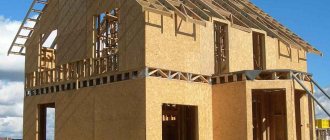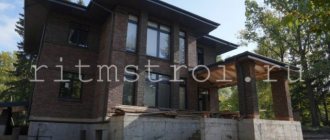Let me make a reservation right away that the article is dedicated to those who really wonder what is better: their own house or an apartment? This article is for those who dream of exchanging an apartment for their own house with a garden. This article is for those who have the strength and at least a little bit of health to run their own household and constantly do repairs in the house and outside.
If you are far away, expensive, unprofitable, have no health, no desire - pass by, don’t waste time reading the article, so that later you won’t bother writing spiteful comments about how traveling by train 200 kilometers ruined you and how you had a stroke while trying to weed carrot. All hateful comments will be deleted
, so as not to litter the site with empty talk and pessimism.
All the best.
And now on the topic for those who are in the know and are simply interested in the experience of a former apartment owner, and now a gardener.
Build or buy? All the pros and cons
There are two ways to become the owner of your own home: buy a ready-made, built cottage or build it yourself. Every decision has its supporters and opponents.
Supporters of buying a ready-made home appeal to the fact that you can move into it immediately. You don’t have to wait until construction is finished, you don’t have to pay rent for another home. Problems with completing documentation and selecting a suitable property can be solved by contacting a reliable real estate agency.
There are no less arguments for independent construction. By giving preference to this method, the future owner will be able to choose the appropriate building materials, monitor the creation of the project, supervise the construction and choose the design of the premises inside the house.
As a result, everything, even the most specific requirements, will be taken into account. And each person, of course, has his own. For some, a balcony and a terrace are important, others need a winter garden, others need a swimming pool, residential roofing, underground garage, etc.
Conclusion
It can be difficult to make the right choice between deciding to build it yourself or buy a ready-made facility. Each of them has positive and negative sides. You should start from the available budget, the amount of time for construction and your strength.
All other things being equal, if you have the opportunity to build your dream home, it makes no sense to buy a completed property. At the same time, in modern cottage villages, developers, as a rule, already take into account most of the preferences of buyers of suburban housing. After all, we all essentially strive to have the right home in a good location. By purchasing such a building from a developer, you don’t have to spend months and years, don’t worry, but just move in and live where you want.
Did you find this article helpful? Please share it on social networks: Don't forget to bookmark the Nedvio website. We talk about construction, renovation, and country real estate in an interesting, useful and understandable way.
Purchasing a ready-made country house: 9 arguments “For”
As already noted, ready-made housing is the optimal solution for those who are not willing to wait. This will allow you to optimize a lot of points for the future owner:
- Minimum hassle, you will only have to spend money once on moving and purchasing furniture and equipment;
- You can immediately register and obtain registration for children (if this is provided in the village);
- Children can immediately go to a new school (kindergarten), and parents can calmly continue to work and live in their usual rhythm;
- You won’t have to spend money on renting and renovating someone else’s house (apartment) while construction is underway;
- A quick purchase and sale transaction that does not require constant involvement of the owner in the process;
- There is no need to spend time monitoring all stages of the construction process, the work of specialists, or attract (borrow) additional money;
- Fixed cost of the purchased property. The final price is known, the house will not cost more;
- Simple registration of all documents and papers. There is no need to run through authorities and collect, prove, transfer and wait for something.
Marketing
Advertisements in the media, banners, street advertising, website on the Internet - all methods can be used to attract buyers. Cooperate with real estate companies, they will provide a constant flow of potential clients.
The main condition for success is quality, comprehensive service and speed of work.
Disadvantages for the buyer when choosing a ready-made country house
Many buyers are held back from purchasing ready-made country housing by the following:
- High price per square meter . It is believed that if you choose the right materials, organize and plan the construction process, organize the space, arrangement of rooms, you can achieve lower costs (and therefore cost) per square meter;
- Doubts about the quality of construction . Any crack in the wall or chipped brick can be a source of doubt. They are amplified if the seller does not have or lacks any documentation;
- You can't choose your neighbors . A country house at an affordable price does not guarantee good relations with the people who own houses located nearby;
- It is very difficult and long to search for a suitable option . The timing of the search, of course, depends on the number of requirements placed on the object. Most often, this problem arises when people are looking for real estate on their own, and not through an agency;
- It is impossible to reach an agreement with the owner . These, of course, are primarily questions about price, payment procedures, preparation of papers and the house for the transaction. But it also often happens that the buyer and seller act on emotions, which leads to conflict situations that have nothing to do with the object of sale;
- Quality and improvement of the land plot . An owner who has purchased a ready-made country house with a plot often has to invest additional funds in it.
In addition, when purchasing a ready-made cottage, the future owner is at great risk. The previous owner may remain silent about unresolved problems (errors in construction, paperwork, debts, encumbrances, etc.), which will subsequently lead to unpleasant surprises and new waste.
After signing all the documents, all disputes with the unscrupulous seller will have to be resolved in court. Litigation can continue for a long time and also costs money. However, the result cannot be predicted.
The middle option is perestroika
It’s a fairly common case when they purchase an already inhabited plot of land. At the same time, the condition and quality of buildings on it varies widely.
At the bottom of this imaginary scale there will be outright construction waste, which is more profitable to take to a landfill than to find its intended use. In essence, we are returning to the option of new construction. However, the lengthy list of paperwork hassles disappears. Sometimes, even the complete dismantling of a building and the construction of a new one in its place can be carried out on paper as a major overhaul or reconstruction of an existing structure.
The top of the scale is very close to the acquisition of a full-fledged residential building, subject to redevelopment or renovation of medium complexity.
Advantages and disadvantages of rebuilding private houses:
- the hassle and time required for paperwork are reduced;
- there is no need to obtain a building permit (one may be required for redevelopment and reconstruction);
- availability of basic ready-made communications;
- existing buildings, fences, utility networks facilitate the organization of construction processes;
- it is difficult to change the location of the house on the site;
- the possibility of major changes in architectural and planning solutions is limited.
By giving preference to methods associated with the reconstruction of an existing house, you can also expand its area by adding new rooms or adding floors.
Independent construction of a country house
Any construction project is a headache. Any developer will confirm this to you.
It all starts with drawing up a project. It can be typical or unique. You won’t be able to do it yourself, without a higher construction or architectural education. You'll have to order from professionals. Thanks to this, you will also insure yourself against mistakes that will negatively affect the reliability and durability of your future home.
The cost of design costs depends on the area:
| Prices for house projects: | |
| Architectural and construction project (AR+KR) | 350 rub/m2 (from 35 thousand rubles); |
| Engineering design (EP) | 200 rub/m2 (from 20 thousand rubles) (electrical, heating, water supply and sewerage) sections separately - 95 rub/sq.m; |
| Estimate for building a house | 100 rub/m2 |
Let's take, for example, that we need to design and build a house of an ordinary, square shape with a wall width of 10x10 m, on two floors, i.e., with an area of 200 square meters. m.
We get:
- Architectural and construction project - 70,000 rubles;
- Engineering project - 40,000 rubles;
- The estimate for building a house is 20,000 rubles.
TOTAL for the project: 130,000 rubles.
After design, the foundation is laid. Most often, in the economy segment of country housing, a strip, shallow foundation is chosen (if there is no base/basement).
The cost of foundation costs depends on the length and width of the sides, as well as the depth of the foundation.
Equipment
There is no need to purchase expensive construction equipment. Depending on the project, at each stage of work you can rent the necessary equipment and personnel from companies specializing in providing such services. Buy only those tools and equipment that are necessary for your work on a regular basis.
If you plan to sell finished wooden houses, the situation looks different. The lumberjack team must be equipped with chainsaws and other equipment for harvesting wood. Equipment for transporting wood to the assembly site can be rented. Assembly, which is best done in winter, is also carried out using chainsaws, electric planes and a standard set of carpentry tools. To operate, you need a mini-power station. The approximate cost of a set of equipment for the work of one team is 50-60 thousand rubles.
The nuances of self-construction
If you still consider yourself a supporter of building on your own, here are a few more important nuances that should be taken into account.
Advantages:
- You can build a house according to your design;
- You can choose what to build from (all materials);
- You can control all stages of construction;
- The opportunity to create a unique interior design and landscape design of the surrounding area.
By preferring independent construction to the purchase of a ready-made country house in the Moscow region, the owner can be confident that all its requirements will be met. He chooses the materials, furniture and household appliances himself.
Flaws:
The main condition for quality construction is timely financing of all work. If the budget is planned incorrectly, there may not be enough funds, which will significantly affect the timing and quality of construction.
The biggest expenses go to the purchase and supply of materials, which are becoming more expensive every day. Even after the completion of the main stages of construction (construction of the foundation, frame, roof), the owner will still have to spend money on construction: finishing work, communications, obtaining a building permit - all this will require money.
Hiring a general contractor
This option is clear for those who do not have financial problems. There’s nothing to even think about here - if you have enough money, then why spend all your time at a construction site by the sweat of your brow, when you can entrust this work to professionals.
However, even if things are not so rosy with your money, we advise you to think about the advantages of this option.
How to choose a general contractor
First of all, select several construction companies that have good reviews on the Internet and in real life. We do not recommend starting your choice by comparing prices, since you can end up building cheaply and then spend twice as much to eliminate the shortcomings.
Contact the selected companies and try to find out the following things from them:
- what types of work the company has licenses for;
- how many projects and what level (large, small) the contractor has already implemented;
- Ask for contacts and addresses of several clients to familiarize yourself with the quality of the contractor's work on site.
Contact the company's clients whose addresses you have received and ask them about their experience working with this contractor. Perhaps not everyone will meet you halfway, but many will be understanding. After all, nowadays it’s not easy to find good contractors, and before starting construction they probably did the same thing as you - they found out whether this contractor could be trusted.
If the company refused to give you the addresses of clients, you should think about it, because no one will hide grateful clients; they are the best “live” advertising for the company.
From personal communication with company clients, you will learn something that you cannot find out anywhere else. You can, of course, first try your luck on the Internet, but it’s not always clear which positive reviews you can trust and which ones were written by the contractor’s employees themselves. You can’t always trust even negative reviews—they can easily be left by employees of another company in competition for the market.
Types of general contractors
There are two main types of general contractors:
- Construction organizations that are engaged in construction themselves and at the same time perform the duties of a general contractor.
- Firms that are not involved in construction, but only search and select subcontractors, organize and control their work on site.
So that you can more clearly understand the difference between construction companies and general contractors, we will tell you more about what they do.
General contractor:
- Calculates the cost of all work (estimate work)
- Manages construction budget expenditures
- Bears full responsibility for the quality and results of construction work.
- Searches, hires, organizes and monitors the work of related organizations - subcontractors. As a rule, these are narrow-profile organizations that are engaged in only one type of activity:
- digging pits,
- foundation construction,
- walling,
- laying floors,
- roof construction,
- installation of doors/windows,
- installation of electrical wiring, plumbing, ventilation, water supply...
- interior finishing works,
- landscaping...
Thus, by contacting a general contractor company, you receive a personal consultant and organizer of work, and also transfer to him the entire burden of responsibility for the execution of work and for their results. All you need is money and periodic monitoring.
Construction company
A construction company, unlike a general contractor, has its own staff of workers in all major specialties, as well as construction equipment. Because of this, she does not need to look for subcontractors and pay them for performing any work; she does everything on her own. The cost of construction is usually calculated from the cost of work plus overhead costs and profit. Therefore, in this option, as a rule, you can save money compared to general contractor companies that pay for the services of subcontractors with an already built-in profit and add their own profit on top.
However, in this case, there is one caveat - if you enter into an agreement with a small construction company, then with some probability it will not be able to perform the entire required range of work on its own and it will still have to attract some specialized specialists, so the cost will increase.
Otherwise, you get everything the same - full responsibility for the performance of work under the contract in accordance with the project.
Summing up and comparing your needs with opportunities
To make it easier to assess whether it is better to build a house or buy a ready-made one, we have compiled two tables.
Table 1. Various options and scenarios depending on the individual wishes of future owners:
| Everything must correspond 100% to individual requests. | Construction of a new building using a project from the catalog or a specially developed one. |
| There is a need for quick check-in. | Purchasing a finished house (new). |
| Purchase of an old house, fully or partially furnished. | |
| There is no opportunity and/or desire to engage in construction | Order turnkey construction from a specialized company. |
| Purchasing a new home. | |
| Purchase of an old house with complete renovation and modernization. | |
| Ordering the construction of a house in a cottage town. | |
| I would like to personally control the purchase of materials and all stages of construction. | Construction according to your own or catalog design, in a cooperative or privately. |
| There is a need to invest funds in parts. | Construction of a house from stone materials requiring lengthy construction. |
Table 2. The following table describes possible scenarios and prices for houses with a total area of about 150 m2. Although if you have $30,000 or less, you will have to look for a significantly smaller house (about half).
| 100 000 | Purchase of a finished brick or aerated concrete house. |
| Construction of a house from aerated concrete or brick. | |
| 75 000 | Purchase of a new aerated concrete or brick house (unfinished). |
| Purchase of a townhouse or frame building (with full finishing). | |
| Construction of a house from ceramic bricks or aerated concrete. | |
| 50 000 | Purchase of an old house, completely ready for habitation (with all communications and finishing). |
| Construction of a frame house. | |
| 30 000 | Purchasing an old house of smaller dimensions with a minimum of amenities (planning to complete and improve it). |
| Construction of a frame building of smaller dimensions. | |
| Purchase of a small townhouse – up to 60 m2. |
Take the survey:
Which option for purchasing a home did you choose:
- Home construction
- Buying a house ready to move in
- Buying an old house with subsequent renovation
View results
Which option for purchasing a home did you choose:
You must select at least one option before voting!
Close
Where does construction work begin?
And it all starts with design. But since the majority of Russians do not have fabulous amounts of money for individual projects, they have to be content with standard projects, which are often modified.
Construction work begins with laying the foundation. The variety of species of this structural element is amazing, but the classic option is the columnar one, which is presented in the form of a reinforced concrete base and columns. After which the construction of walls begins; foam blocks, cinder blocks, bricks and much more can be used here. Next comes the roofing, the most inexpensive is still slate, but many prefer metal tiles, thanks to it many Russian houses are similar to each other. Such a roof is much more expensive than a slate roof.
After roofing work, builders begin to work on windows, and in this regard, nothing better than plastic double-glazed windows has yet been invented. Fortunately, their choice is huge, and therefore the price range can literally continue indefinitely.
Who is who?
Judging by advertisements and publications in the press, the term “country market” is synonymous with the concept of “cottage communities.” However, this is not quite true. Today, in the Moscow region, houses for sale are being built by hundreds, or even thousands of private developers.
Unfortunately, there are no clear statistics on such “individual” developers, but we can confidently assume that this market is quite large. Experts believe that the market for private developers near Moscow and the supply of cottage villages are quite comparable in terms of volume. Thus, the annual turnover of this market segment is estimated at billions of dollars. e.
Although this phenomenon is quite large-scale, there is little information about private developers. Private owners can be considered smaller market players than developers of a large number of cottages in one village. They have no desire to create brands, they do not use PR and advertising. In addition, small developers deliberately try to avoid any publicity.
However, it is worth paying attention to the fact that “individual” developers are quite a serious force. Several years ago, one large-scale development company did not acquire an excellent plot of land for the construction of a village, citing the fact that a certain gentleman with connections with the administration was already working in that region, there were better pieces of land and construction projects had already begun
The company simply saw no point in competing with him.











